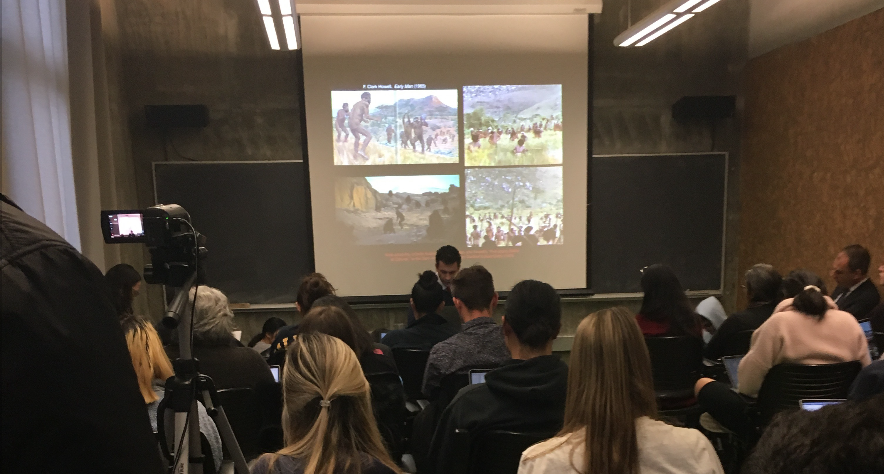HTNM Revisited: Stefanos Geroulanos

Recap by Tara Shi, 2018 - 2019 Graduate Liaison for the History Theory and New Media Lecture series
What are tools? And what defines us as being human?
In his talk, Stefanos Geroulanos calls attention to the ‘history of prehistory,’ emphasizing an interest not in what ‘exactly’ happened, but how human origins were culturally constructed in the past 150 years. Focusing in on Europe and the US during the 1950-1970s, Geroulanos traces two interconnected traditions, put in short as nature and technique. Against a backdrop of emerging futures like nuclear technology and the space age, he meticulously positions work from archeologists, theorists and technologists alongside that of filmmakers, artists and popular culture.
As a scaffold for the nature tradition, Geroulanos turns to Stanley Kubrick's epic 2001 Space Odyssey (1968) and three central characters—the Ape-human, HAL 9000, and the Starchild. Built on Cold War paradigms propelled by Richard Ardrey and Raymond Dart and made popular by prolific publications and paleo-artists, the nature tradition posited that weapons fashioned humans. From the start, it was our unique violence that allowed a sharp break from nature to birth humanity and culture. In this ontology, Geroulanos explains, a return to a gory “bone-logic,” or the innate aggression in our species, is the only way to overcome our technological bounds towards self-transcendence—to become the Kubrickian starchild. The ‘out of Africa’ nature tradition, tainted by motivations towards state power and racial superiority, rationalizes modern violence in support of techno-humanism.
For the second tradition of technique, Geroulanos draws together contributions from British researchers Kenneth Oakley and Wilfrid Le Gros Clark, prominent fossil prospector Lewis Leakey, anthropologist Sherman Washburn, and technologist André Leroi-Gourhan. For him, this cast of characters empirically “displaced skulls with teeth, hands and pelvises,” prioritizing the cybernetic concept of feedback loops in the use and making of tools that ultimately forged humanity.
Geroulanos describes that in the technique tradition, a shift in focus from innate characteristics to external relations refuted residual scientific racism in the nature tradition. “Tools were not artifice but between nature and culture,” Clark claimed. Oakley furthered this work with theories on the importance digging for implements in the field and the rigorous natural selection of culture tradition over heredity that lead to changing hominid morphology.
In 1959, Louis Leakey discovered Zinjanthropus the ‘oldest known toolmaker,’ and homo habilis a year later. Following up Oakley’s revisions of Clark, Leakey reconstructed a narrative of side by side evolution with these discoveries. Zinjanthropus, as Geroulanos describes, radicalized the discussion the debunked previous theories as fundamentally Eurocentric, using evidence of its small brain, geography and genealogy.
Like his predecessors, physical anthropologist Sherwood Washburn sought a “hard neurological basis for links between tools and the brain” and supported a “multi-regional, anti-racist” mapping of human origins in the form of a cybernetic matrix rather than a linear tree. Relying on darwinism, genetics, and what he termed ‘adaptive complexes’ instead of typological explanations like racial difference, Washburn reversed the entire anticipated order of evolution. Geroulanos describes Washburn’s interpretation of the homunculus as plastic; the brain was an “extraordinarily efficient computer,” and archive of physiological changes. In fact, it was tools that created homo sapiens: the brain, face, head physiological changed after the use of tools, with locomotion coming before that.
Moving on, Geroulanos looks at André Leroi-Gourhan’s application of anthropology techniques to the body. Leroi-Gourhan carefully tracked jugal hinge morphosis to understand how the use of tools with hands transformed the head. Using structuralist accounts of paleolithic art and Zinjanthropus as evidence, Leroi-Gourhan considered the body itself is a cybernetic device. Further, he hypothesized that tools were not individual, but involved in the corporeal and social practices of memory, teaching, and gestures in their fabrication and use. Unlike other animals where memory is internal, Geroulanos explains, “operative memory is externalized.” For Leroi-Gourhan, “every being that walks upright, free hand during, relatively large brain, mobile transportable tools is human. Language, civilization, religion is optional.” Geroulanos explains that tools decenter the human; we do not control evolution, and our species faces a “dire self-enclosure from logic specific to technology.”
For Geroulanos, prehistory is a “decidedly modern history.” Following the technique tradition, the body is no longer confined as an “organism versus environment problem,” but rather an assemblage that is “built and rebuilt constantly.” Everything is a tool—”stones, pelvises or machines”—and the meaning of tools, in the wake of these traditions, continue to be shaped by politically diverse responses from Marshall McLuhan, Gregory Bateson, Donna Haraway, Gilles Deleuze and Félix Guattari, to Jane Goodall. Ending on a darker note, Geroulanos suggests that the nature, or violence argument may have been forgotten: “In radically expanding these tools, these thinkers have played out the dreams and anguish of technology. Now that technology has escaped manual human industry, it is capable of dissecting the human at the same time that it powers ecological catastrophe.”
